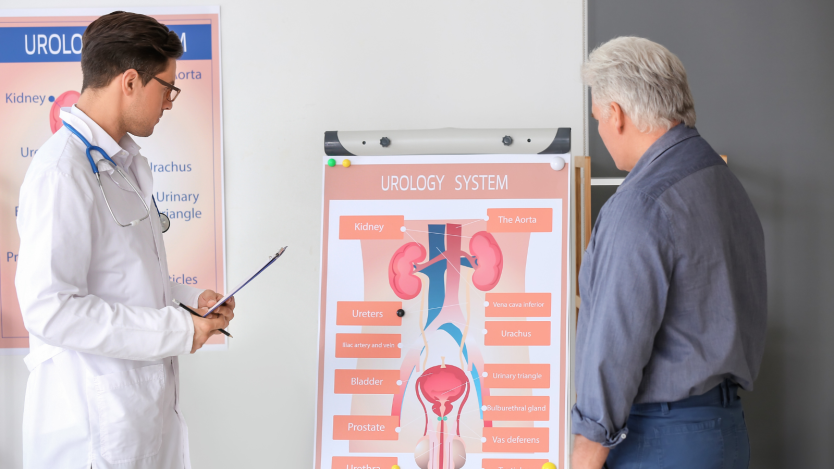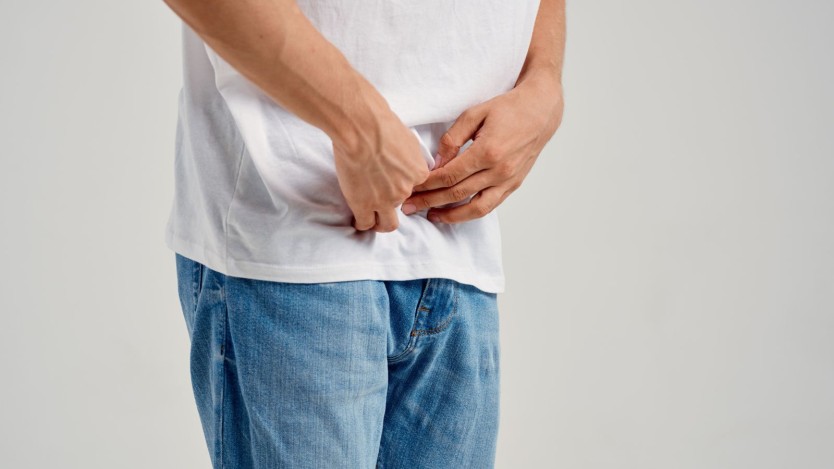What is the normal prostate size?

- General facts about the prostate
- What is the prostate?
- What is benign prostatic hyperplasia or BPH?
- What are the symptoms of an abnormally enlarged prostate?
- What is the cause of prostate enlargement?
- Treatments for abnormal prostate enlargement
- Surgical assessment consultation with the Urologist
- Frequent Questions
General facts about the prostate
- The normal weight of the prostate is around 20-25 grams and its size is approximately 3 cm x 4 cm x 2.5 cm.
- The prostate does not stop increasing in size throughout life, which is the reason for benign prostatic hyperplasia.
- The only definitive solution to alleviate the symptoms caused by the abnormal enlargement of the prostate is surgery.
What is the prostate?
The prostate is a gland unique to the male genital tract. The prostate is made up of muscular and glandular tissue, with a normal volume of approximately 20 cubic centimetres and a weight of around 20-25 g.
The specific location of the prostate is in front of the rectum, which is the end of the intestine, surrounding the neck of the bladder and the urethra.
The prostate is shaped like a "chestnut" and has an elastic consistency, with a smooth surface and a groove that divides it into two more or less symmetrical halves.
The prostate surrounds the tube that carries urine from the bladder to the outside of the body.
The function of the prostate is to produce seminal fluid, along with glands around the urethra (the tube that carries urine out through the penis) and seminal vesicles.
The prostate is composed of several types of tissue. In simplified form, we can describe these tissue types as follows:
- Muscle tissue. Tissue composed of muscle fibres found around the urethra in the central portion of the prostate.
- Glandular tissue or tissue composed of glands. Glands are small formations that are responsible for secreting substances, in the case of the prostate, components of seminal fluid. Glandular tissue is usually found localised throughout the prostate and is most abundant surrounding the muscle tissue in its central region.
- Stromal tissue. Stromal tissue is a specific type of tissue formed by cells that perform the function of supporting and shaping a given organ. This type of tissue is scattered throughout the prostate mass, therefore, its affectation will favour an increase in the size of the prostate in a diffuse manner.
The prostate is only partially palpable on its posterior aspect through the wall of the rectum by digital rectal examination, one of the most common and effective diagnostic methods to determine whether benign prostatic hyperplasia, prostate cancer or prostatitis is present.

Free Assessment for Contracting Medical Services
Operarme’s Patient Service will contact you and solve all your questions on the medical service you need.
What is benign prostatic hyperplasia or BPH?
Benign prostatic hyperplasia (BPH) is a disease with a number of anatomical features and a number of prostate-related symptoms. These characteristic symptoms of BPH are:
- Increase in the size of the prostate gland, basically caused by an increase in glandular and muscular tissue.
- Obstruction and irritation to a greater or lesser degree of the lower urinary tract and alterations in the quality of life of patients, mainly above 50 years of age.

Abnormal enlargement of the prostate is established as soon as the prostate reaches a prostate weight greater than 30g:
- Peak urine flow of less than 15 millilitres per second (measured by a specific test called urinary flowmetry).
- Alterations related to urination that negatively influence the patient's daily life (measured using the IPSS scale).
What are the symptoms of an abnormally enlarged prostate?
The enlargement of the prostate causes, as we saw in the previous paragraphs, a series of specific prostate symptoms. These symptoms can be divided into obstructive symptoms and irritative symptoms.
It is generally considered that the prostate will present symptoms of both groups for the vast majority of its evolution, with obstructive symptoms being more evident in the early stages of benign prostatic hyperplasia and irritative symptoms becoming more evident as the disease evolves and the prostate increases in size.
Below are some key points about the two symptom groups:
Obstructive symptoms
The size of the prostate will mark the presence of obstructive symptoms such as:
- Difficulty in the onset of urination and a delay in the onset of urination.
- Decrease in the force of the urinary stream and its calibre, intermittent and prolonged urination, as well as dribbling after completion of urination.
- Sensation of incomplete emptying of the bladder and retention of urine (with increased postvoid residual - the amount of urine remaining in the bladder after urination, pathological if greater than 100 cc).
Irritative symptoms
The size of the prostate, especially in more advanced stages of benign prostatic hyperplasia, will cause the appearance of irritative symptoms such as:
- Urinary urgency or the sudden onset of the urge to urinate.
- Urinary frequency or increased frequency of urination in a day.
- Nocturia or an increase in the number of times the patient has to get up at night to urinate.
- Appearance of pain in the lower abdomen.
- Mild incontinence or inability to hold back urine when the urge to urinate or the immediate desire to urinate occurs.
What is the cause of prostate enlargement?
Prostate enlargement is slow and virtually non-existent until the age of 30, at which point it generally begins to gradually increase in size.
On a regulated basis it is established as the average annual growth of prostate size of about 1.6% of prostate volume each year until the fifth decade of life when it increases at an average rate of 0.4 g per year until the patient's death.
This means that the prostate is a continuously growing organ and therefore the normal size of the prostate will progressively increase.
Normal prostate enlargement has three components with varying degrees of involvement in each individual:
- Growth of normal prostate size from stromal tissue. Stromal tissue is found throughout the prostate, so its growth affects it diffusely.
- Growth of normal prostate size from glandular tissue. Glandular growth may predominate in the transition zone of the prostate (central region around the urethra) and also more laterally.
- Growth of normal prostate size from muscle tissue.
From the age of forty onwards, prostate enlargements develop, made up of varying proportions of the three components mentioned above.

This means that growths of normal prostate size in this decade of life may occur at the expense of one type of tissue or the growth of several types of tissue.
BPH tends to become more evident with ageing, in men over the age of 40.
In men aged 50-70 years, 86% of prostate enlargement occurs mainly in the transitional zone, with the glandular component predominating.
The causes of prostate enlargement or benign prostatic hyperplasia are not unique and involve a number of different factors:
- Advanced age.
- Increase in oestrogen and some metabolites of testosterone.
- Increased activity of certain enzymes that convert testosterone into other substances.
- Genetic and dietary factors may also be involved, but to a lesser extent.
Treatments for abnormal prostate enlargement
Initially, patients who begin to experience an increase in the normal size of the prostate and see a urological specialist often choose to take medication to alleviate the symptoms of BPH.
Drug treatment can be used during the early stages of BPH, but the ultimate solution is surgery.
The problem is that the prostate, as we have already mentioned, does not stop growing throughout life, growing differently in each patient, so there comes a time when pharmacological treatment becomes ineffective.
In these cases, the most advisable option is to submit the patient to prostate surgery, which may be:
- Reductive surgery, which consists of reducing the size of the prostate by removing and extracting the prostate tissue obstructing the urethra.
- Treatment of a liberating nature, which consists of freeing the urethral channel by means of a novel technique called urethral liberation with the Urolift system.
The use of one technique or another to reduce the size of the prostate will depend on the patient's characteristics, the surgeon's opinion and, above all, the size of the prostate, as not all surgical techniques are suitable for all prostate sizes.
To learn more about the different prostate interventions, click on the following links:
Surgical assessment consultation with the Urologist
If you are suffering from the discomfort and pain caused by an enlarged prostate, benign prostatic hyperplasia, and you want to solve your symptoms as soon as possible, you can call at +34 91 141 33 56 or fill in the contact form so that our patient service department can contact you and arrange an appointment in the best private hospitals in Spain with which we collaborate.
You can also click on the following image to request an immediate and free surgical assessment consultation with our Urology Specialists:

Do you need prostate surgery?
Request a free and immediate appointment with our specialists in Urology
Medical disclaimer: All the published content in Operarme is intended to disseminate reliable medical information to the general public, and is reviewed by healthcare professionals. In any case should this information be used to perform a diagnosis, indicate a treatment, or replace the medical assessment of a professional in a face to face consultation. Find more information in the links below:
Frequent Questions
-
¿Cuándo se considera grande la próstata?
El aumento anormal de la próstata se establece cuando alcanza un peso prostático superior a 30 g. Esto provoca una serie de síntomas:
- Dificultad para orinar.
- Disminución de la fuerza del chorro de la orina.
- Sensación de vaciado incompleto.
- Mayor necesidad de miccionar.
- Leve incontinencia. Leer más.
-
¿Cuál es el tamaño normal de la próstata en un adulto mayor?
La próstata está formada por tejido muscular y glandular, cuyo volumen normal es de aproximadamente 20 centímetros cúbicos y un peso que ronda los 20 - 25 g. Leer más.
-
¿Cuál es la medida correcta de la próstata?
El peso normal de la próstata es alrededor de unos 20- 25 gramos, siendo su tamaño de alrededor de 3 cm x 4 cm x 2,5cm aproximadamente. Leer más.
